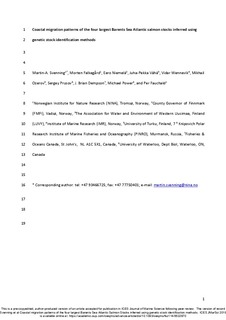Coastal migration patterns of the four largest Barents Sea Atlantic salmon stocks inferred using genetic stock identification methods
Svenning, Martin-A.; Falkegård, Morten; Niemäle, Eero; Vähä, Juha-Pekka; Wennevik, Vidar; Ozerov, Mikhail; Prusov, Sergey; Dempson, J.Brian; Power, Michael; Fauchald, Per
Peer reviewed, Journal article
Accepted version

Åpne
Permanent lenke
http://hdl.handle.net/11250/2616960Utgivelsesdato
2019Metadata
Vis full innførselSamlinger
- NINA Rapport/NINA Report [2343]
Originalversjon
10.1093/icesjms/fsz114.Sammendrag
Combining detailed temporal and spatial catch data, including catch per unit effort, with a high-resolution microsatellite genetic baseline facilitated
the development of stock-specific coastal migration models for the four largest Atlantic salmon (Salmo salar) populations, Ma˚lselv,
Alta, Tana and Kola rivers, contributing to the Barents Sea mixed-stock fishery. Ma˚lselv salmon displayed a restricted coastal movement with
85% of the fish captured within 20 km of their natal river. Kola salmon also demonstrated limited coastal movements in Norwegian waters,
with most (> 90%) caught in eastern Finnmark. Multi-sea-winter (MSW) Alta salmon were caught west of Alta fjord across a broader stretch
of coast while one-sea-winter (1SW) fish migrated more extensively along the coast prior to river entry. Tana salmon, however, were detected
over a broad expanse (600 km) of the North-Norwegian coast. For all populations MSW salmon dominating catches earlier in the season
(May–June) while 1SW fish were more common from July to August. This study provides an example of how traditional catch and effort information
may be combined with genetic methods to obtain insights into spatial and temporal changes in Atlantic salmon catch composition
and their associated migration patterns in a mixed-stock coastal fishery.